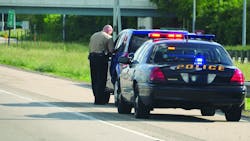Are Move Over Violations A National Crisis? Data Says Yes
Imagine someone driving down the road, faster than the posted speed limit, music blaring, when out of the corner of their eye they see red and blue flashing lights. Before they know it, this person loses control of the vehicle and hits an officer who was just trying to do his or her job. Now, someone must explain to the family why he or she is not coming home tonight.
Across the country, roadside workers are being struck and killed while a law goes unenforced. Move Over laws require drivers to change lanes or slow down when law enforcement vehicles and other emergency vehicles, such as, fire, rescue, construction, or tow trucks, are stopped on the shoulder of the road with emergency lights in operation. The law is only as valuable as its application, and unfortunately Move Over violations are difficult to enforce, posing a national crisis.
The first Move Over law was implemented in 1996 in South Carolina, after a paramedic who was struck and injured, and found to be at fault for stepping into the roadway, lobbied for increased protection for emergency medical responders. Since then, all 50 U.S. states have implemented a form of the Move Over law to try and reduce or prevent such risk and tragedy. Sadly, it’s not working. According to the National Law Enforcement Officers Memorial Fund, more than 150 law enforcement officers have been struck and killed by vehicles along America’s highways since 1999. “Struck by Vehicle” is the fourth highest cause of police officer death since 2008.
Unfortunately, most citizens either don’t realize the laws exist or they choose not to follow them. But when an officer is conducting a traffic stop, they can’t be held responsible to also monitor their own safety or cite and flag Move Over violations that occur. How can we educate drivers before they get behind the wheel, while also protecting the well-being of our law enforcement officers and other roadside workers? A ticket and a fine would likely make a driver think twice the next time they’re on the road, but how do we cite them in the first place when they’re flying by an officer that is already conducting a stop?
The answer could be the adoption of innovative technologies that can do the work of violation capture and citation for the officer, in real time, while they conduct their traffic stop. There are technologies available in the market—innovative camera and license plate reader solutions—that affix to a patrol vehicle, tow truck, or any other emergency vehicle, and capture the violation as it happens. And guess what? It works.
Rekor Recognition Systems, recently conducted field studies in conjunction with multiple law enforcement agencies and tow operators in Ohio, Maryland, and New York, and the numbers were startling: 1,879 violations during 134 traffic stops. With an average stop time of 11 minutes, Rekor recorded approximately 14 violations per stop during the test period. That’s 14 times per stop that a roadside worker’s life was in danger because of a violation of the Move Over law. This is just a small sample size, imagine the numbers when extrapolated on a national scale.
While the responsibility falls on the shoulders of the driver, law enforcement agencies have taken a more proactive approach toward deterring violations by implementing stricter penalties. Over the years we’ve seen many states increase penalties to include stiffer fines, suspended licenses, or even incarceration. While these penalties may strike fear in some to pay closer attention, the issue still remains that law enforcement simply cannot react quickly enough to catch most offenders. If an officer is already on the side of the road when the violation occurs, it is nearly impossible to get back in their vehicle, leave the stop they are currently on, and issue a citation to a driver who may be several miles beyond where the violation occurred. Ultimately, the lack of consequence leads to more violations, more accidents, and more fatalities.
Rekor’s Move Over field studies were conducted using the company’s proprietary technology that captures violations in real-time using multiple high-resolution video cameras, digital tracking radar, and AI-based license plate recognition software. The system provides video and data evidence of infractions, which would ultimately be reviewed and approved for issuance only by law enforcement personnel.
While this solution may not bring an end to Move Over law violations, it is a significant step in the right direction that will lead to dramatic improvements in compliance, and ultimately help to save lives.
As a fellow driver, I understand that sometimes we are in a rush to get to our destination and that distractions happen. However, the few seconds it takes to focus, move over, or slowdown could not only save someone else’s life but can save the driver’s as well. While it is improbable to eliminate Move Over violations, it is imperative that communities nationwide are educated about responsible actions while providing law enforcement agencies access to the most advanced tools available.
About the Author

